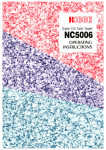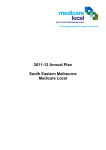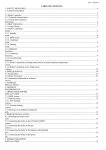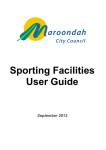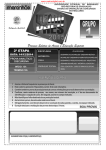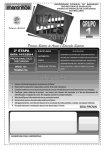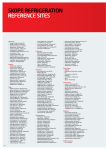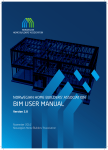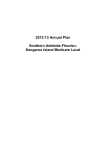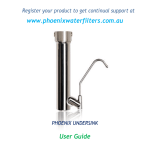Download Medicare Local Annual Plan template and user guide
Transcript
2012-13 Annual Plan Eastern Melbourne Medicare Local Document History This table is to record the document’s history, i.e. dates of submission and any resubmission to the Department following revisions. As each version is drafted and submitted, the version number and summary of changes made should be recorded below: Version No. 1.0 Date 10 August 2012 Description of Revision th 2012-13 Annual Plan for Eastern Melbourne Medicare Local Version June 2012 1 Table of Contents Checklist and Attachments ...................................................................................... 2 Annual Plan Checklist............................................................................................ 2 Attachments ........................................................................................................... 2 1 Organisational overview .................................................................................... 3 1.1 1.2 1.3 1.4 1.5 1.6 1.7 1.8 1.9 1.10 2 Medicare Locals Core Funding Program ......................................................... 15 2.1 2.2 3) 2.3 2.4 3 Medicare Local contact information .............................................................. 3 Medicare Local region characteristics ........................................................... 4 Strategic Direction ......................................................................................... 7 Organisational structure and internal governance.......................................... 7 Board membership ......................................................................................... 8 Company membership ................................................................................... 9 Company objects .......................................................................................... 11 Key stakeholder relationships ...................................................................... 11 Subcontractors.............................................. Error! Bookmark not defined. List of attachments ....................................................................................... 14 Key activities ............................................................................................... 15 Risk management plan – Medicare Local core funding program (Schedule Error! Bookmark not defined. Transition arrangements............................................................................... 20 Additional Program information or Program material................................. 21 Medicare Local After Hours Program ............................................................... 21 3.1 Key activities ............................................................................................... 21 3.2 Risk management plan – Medicare Local After Hours Program ..........Error! Bookmark not defined. 2012-13 Annual Plan for Eastern Melbourne Medicare Local Version June 2012 1 Checklist and Attachments Annual Plan Checklist A cover letter has been provided to the Department, confirming that the information in the Annual Plan is correct and has been approved by the Medicare Local’s Board of Directors. The cover letter should also acknowledge that it is an offence under Section 137 of the Criminal Code Act 1995 to provide false or misleading information or documents to the Commonwealth. All parts of the Annual Plan template have been completed and the personnel completing and authorising the plan have reviewed the Department’s instructions, rationale and assessment outline set out in the plan template. The plan includes page numbers. Activities are uniquely numbered (refer to the Instructions under Section 2.1 – Key Activities). Suggested sections not for public release are highlighted for consideration by the Department (refer to “Submission of the 2012-13 Medicare Locals Annual Plan & Annual Budget”). A correctly rendered invoice for the associated payment has been submitted (refer to Deed Schedule 1, Item E, General Invoice Provisions). The Annual Plan will be posted on the Medicare Local’s website once approved by the Department (and once the sections not for public release have been removed) (refer to “Submission of the 2012-13 Medicare Locals Annual Plan & Annual Budget”). Template guidance set out in blue text has been removed. Attachments The following attachments have been included: Organisational chart(s) A copy of the Medicare Local’s full Constitution A copy of certificates of currency for all required Insurances (refer to Section 1.9) A copy of the register of Assets (refer to Section 1.9) Any other attachments listed under Section 1.9 2012-13 Annual Plan for Eastern Melbourne Medicare Local Version June 2012 2 1 Organisational overview 1.1 Medicare Local contact information Medicare Local name: Eastern Melbourne Medicare Local Medicare Local legal name (if different): ABN: Postal address: Eastern Melbourne Medicare Local Ltd Street address: 21 -23 Maroondah Highway Croydon VICTORIA 3136 Phone: Fax: Email: +61 3 9871 1000 +61 3 9879 5407 [email protected] Website: www.emml.com.au Branch office information: Clinical Service Sites: Lilydale, Healesville, Yarra Junction, Angliss Hospital co-location, Knox Ozone CEO Kristin Michaels (Permanent CEO) CEO +61 408 399 505 [email protected] Sarah Eames Director Health Planning & Development +61 423 877 597 [email protected] Annual Plan contact: 45 828 538 184 21 -23 Maroondah Highway Croydon VICTORIA 3136 2012-13 Annual Plan for Eastern Melbourne Medicare Local Version June 2012 3 1.2 Medicare Local region characteristics Community Location: The Eastern Melbourne Medicare Local catchment incorporates Local Government Areas of Maroondah, Knox and Yarra Ranges. The catchment has a population profile that is split between established urban suburbs and rural communities. The total population for the catchment is 411,105 (ABS 2006) or 10% of metropolitan Melbourne. In total 34% of the population are under the age of 25 years and 12% of the population 65yrs and over. The population is expected to grow by 12.2% by 2031 with the under 25’s expected to grow by an average of 20% and the population over 65 years of age is expected to increase by on average 25%. The 2006 Census data indicates that 1816 people in the catchment identify themselves as Aboriginal or Torres Strait Islander, which comprises 0.5% of the total catchment population and 5% of the total aboriginal population resident in Victoria. Approximately 20.3% of the Eastern Melbourne population was born overseas, of which 11.2% were born in a non-english speaking country. Languages spoken include Cantonese, Mandarin, Italian, German, Dutch and Greek foremost. The life expectancy across the three local government areas is similar to the life 2012-13 Annual Plan for Eastern Melbourne Medicare Local Version June 2012 4 expectancy across Victoria with males Knox and Yarra Ranges having a slightly higher life expectancy of 80.5yrs compared with the Victorian average of 79.7. Socio-Economic Status: The average SIEFA index for the whole catchment is 1045. The median SEIFA score in the EMR is 1061.The mean SEIFA score in EMR is 1063. However, the SEIFA index identifies pockets of significant disadvantage within the catchment, including Yarra Ranges Central (983) and Warburton surrounds (Yarra 967): Yarra Ranges has three of the five most disadvantaged pockets within the catchment. It also includes the most disadvantaged pocket within the catchment. Almost half (12 of the 28) of the postcodes in Yarra Ranges have a SEIFA score lower than the median. All of the postcodes in Maroondah have a SEIFA score lower than the median. Seven out of the nine postcodes in Knox have a SEIFA score lower than the median. The most variation in levels of disadvantage occurs within Yarra Ranges. It includes three of the top five most disadvantaged pockets in the catchment and two of the ten least disadvantaged pockets in the catchment. There are 105, 046 families in the catchment of which 8% are single parent families. The highest proportion of single parent families are in Bayswater, Boronia, Croydon and Lillydale. These areas also have the highest portion of: families with children under the age of 15 that experience some kind of joblessness. Long term unemployed Low income and welfare dependant families Health Care Card Holders Age Pensioners Disability Support Pensioners Health Status across the EMML: People residing in the catchment are slightly more likely to rate their health as fair or poor (14.7%) compared with the Victorian average (13.5%). Across the three LGA’s, residents in the Yarra Ranges catchment are most likely to rate their health as fair or poor. While residents in Ringwood and North West Knox have the highest portion of people who rate their health as Very good or excellent. The overall prevalence of chronic disease across the catchment is similar to the Victorian average with 3.4% of the population diagnosed with Diabetes and 27% with some type of respiratory disease. There are slightly higher rate of mental illness (12%) and high cholesterol (6%) compared with the Victorian average. The prevalence rates for risk factors which influence health outcomes across EMML are slightly higher than the Victorian average. In total 56% of the population across EMML exhibit at least one risk factor: Rates of smoking are 20% compared with 19% across Victoria Rates of overweight or obese adults are 56% for males and 39% for females compared with 54% and 38% for Victoria respectively The levels of inactivity is 34% compared with 33% for Victoria. 2012-13 Annual Plan for Eastern Melbourne Medicare Local Version June 2012 5 There is a lower uptake of cervical cancer and breast cancer screening Specific catchments in the Yarra Ranges, such as Central Yarra Ranges, and Warburton exhibit higher levels of risk factors compared with other areas across the catchment. Access to Health Services: General practice is the primary point of contact for most of the community and as such is the gateway into the broader health system. Eighty percent of Victorians visited one or more GPs in 2004-05 and general practice providers the majority of care to patient with a chronic illness, especially those with mild to moderate severe disease. Forty percent of Community Health Services (CHS) in Victoria offer general practice services and a high proportion of patients of these services come from high needs or vulnerable communities. There are 95 General Practices, 3 public hospitals and 4 CHS in the catchment (3 of which offer GP services). Within the catchment the areas within the Yarra Ranges and surrounding outer metropolitan suburbs have been identified as districts of workforce shortage, due to the low number of GPs for the population; There are a total of 448 General Practitioners working in the catchment of which 39% are female, 10% are international medical graduates (mainly working in areas of district of workforce shortage) and 27 GP Registrars. Alongside GP’s there are 188 practice nurses. The most common reasons for admission to hospital in the eastern region are diseases or disorders of the circulatory system, digestive system and kidney tract. Mental health service usage continues to rise in the catchment with the exception being young people who rarely initiate contact. Navigating mainstream services continues to be a challenge for many residents in particular those from vulnerable communities or CALD backgrounds. 2012-13 Annual Plan for Eastern Melbourne Medicare Local Version June 2012 6 Improved access to primary health care services reduces the presentation and admission of Ambulatory Care Sensitive Conditions (ASCS) within a hospital setting. The top four ASCS presentations for the EMML catchment for 2004-05 are; Diabetes, dehydration, dental, and COPD. 1.3 Strategic Direction At the time of submitting this plan EMML has held one strategic planning session with key stakeholders from across the catchment as part of developing the Strategic Plan which is due for submission on 30th September 2012. A consultant has been engaged to work with the Board to develop the Strategic Plan. Broadly however, it is anticipated that the Strategic Plan will enable EMML to deliver on the company objects outlined in the Constitution. 1.4 Organisational structure and internal governance See attached: Governance Structures Organisational Chart 2012-13 Annual Plan for Eastern Melbourne Medicare Local Version June 2012 7 1.5 Board membership Position on board Name Expertise Current Profession Date of Appointment 1.Chair Leanne Raven Community Equity CEO 18 June 2012 Organisational Development 2.Deputy Chair Dr Peter Trye General Practice GP Medical Administration Director of Medical Services, Angliss Hospital, Eastern Health Public Health 3.Treasurer Jan Fitzgerald SIDS and Kids Australia Corporate Sustainability Sustainability Manager CPA - Finance Coles 18 June 2012 25 July 2012 4.Board Member Dr Alexandra Murray General Practitioner GP, Practice Principal 25 July 2012 5.Board Member Dr Heather Allen General Practitioner GP 18 June 2012 6.Board Member Prof. Frank Archer Research in General Practice and Community based emergency management Emeritus Professor 25 July 2012 Community Health CEO Health Senior Executive 25 July 2012 GP, Practice Principal 25 July 2012 7.Board Member Peter Ruzyla 8. Board Member Barbara Hingston Governance 9. Board member Dr Barbara Inness General Practitioner Practitioner Regulation Monash University 25 July 2012 EACH, Social and Community Health (Previous Chair ERGPA) Transitional arrangements for Board appointments Not applicable. 2012-13 Annual Plan for Eastern Melbourne Medicare Local Version June 2012 8 1.6 Company membership Membership structure Membership to EMML is available to both individuals and organisations engaged in or with primary health care within the EMML catchment and/or who display a bona fide interest in the achievement of the objectives of EMML. As founding members, ERGPA memberships transition to EMML membership automatically as of July 1 2012. GPs practicing in the Cities of Knox, Maroondah or the Shire of Yarra Ranges have the opportunity to be considered for membership. Registered Primary Health Care Providers practicing in the Cities of Knox, Maroondah or the Shire of Yarra Ranges have the opportunity to be considered for membership. Organisations that display a bona fide interest in the achievement of the objectives of EMML will also have an opportunity to be considered for membership. Individuals that display a bona fide interest in the achievement of the objectives of EMML will also have an opportunity to be considered for membership. EMML is accountable to its members for the sound governance of the organisation, giving each member, be it an individual or an organisation representative, the right to attend and have one vote at general meetings. Engagement Strategies To ensure future EMML memberships are reflective of the full spectrum of primary health care in Melbourne’s Outer East, engagement strategies have been developed to ensure targeted recruitment is sound and effective and memberships are long term. It is planned that membership numbers will grow with the roll out of these strategies. Below is the Engagement Plan structure we are using during this process, with some additional information; the rationale and some detail of planned activities we have/are undertaking which will see an increased engagement level over time. 1. Situation Analysis - EMML vision/mission EMML aim & objectives Stakeholder groupings Stakeholder needs analysis 2. Engagement strategy - Defining EMML’s key messages Key communications channels What we aim to achieve Prioritisations 2012-13 Annual Plan for Eastern Melbourne Medicare Local Version June 2012 9 3. Engagement plan - Activity plan (key activities, responsibilities, priorities & resources required) Review activity plan (strategic, measurable, attainable, relevant, timely) 4. Evaluation - Tools & processes for evaluation 5. Sustaining the plan - Activities Continued Resources Responsibilities for sustaining the plan At present we are working across stages 1&2 of the Engagement Plan. First and foremost it is EMML’s priority to ensure the continuation of services and support are delivered and available to all general practices throughout our catchment and further, their patients. Communications supporting this priority have been rolled out, by way of resources, both hard copy and electronic, and individual practice visits to both EMML’s founding members and those targeted General Practices within our new catchment. Personal invitations to become EMML members have been rolled out to GPs and practices throughout the cities of Knox & Maroondah with follow up practice visits now taking place. Initial research indicates 51 new General Practices and approximately 262 individual GPs from the city of Knox and Maroondah now have the opportunity to become members of EMML. Who are EMML’s key stakeholder groups? We are currently determining our primary markets and developing databases reflective of these prospects. This will ensure we use the most effective and direct forms of communication to the right people/organisations at the right time. Below is the list of stakeholder groups we have identified and currently working on: - General Practice & Individual GPs Allied Health Providers & their organizations Medical Specialists Existing Divisions of General Practice Other Medicare Locals Peak Health Bodies Local Government Representatives Local Hospitals Representatives 2012-13 Annual Plan for Eastern Melbourne Medicare Local Version June 2012 10 Category Number of Organisational Members Number of Individual Members Medical General Practice 230 Community members 1 1.7 Company objects The object of the Company is to improve the health of the local community and achieve measurable health outcomes through, amongst other things: . 2.1.1 Encouraging and supporting improvements in the delivery of primary health care services to the community including initiatives aimed toward improving disease prevention and management, raising individual and community awareness and improving access to appropriate services. . 2.1.2 Improving the planning of primary health care services to identify health needs of the community, develop locally focused and responsive health services and address service delivery gaps; . 2.1.3 Supporting primary care and upholding the centrality of general practice for the delivery of effective integrated health management for the local community; . 2.1.4 Providing support to clinicians and health service providers to improve their care; . 2.1.5 Establish, support and enhance effective collaborations to deliver more coordinated, integrated, flexible and locally responsive health services; and . 2.1.6 Foster and maintain a culture of efficiency, accountability and continuous improvement in the delivery of primary health care services. 1.8 Key stakeholder relationships Patients and consumers (including Aboriginal and Torres Strait Islander representatives) Mechanisms by which to engage community members by web based platforms and social media tools will be implemented on the new EMML website expected 2012-13 Annual Plan for Eastern Melbourne Medicare Local Version June 2012 11 to launch in September 2012 Consumer representatives are appointed to sub-committees, and the Consumer Council will be established for EMML by May 2013. Feedback to community forums regarding performance on key indicators through: o Feedback through formal consumer meetings o Media coverage of key performance measures o Website feedback o Waiting room publications of key messages and information Ongoing collaboration with Mullum Mullum Indigenous Gathering Place and Healesville Indigenous Community Services Association (HICSA) regarding programmes to maximise Aboriginal and Torres Strait Islander engagement. Work alongside the Outer East PCP to maximise community and consumer engagement into defining the local health needs of the community. Clinicians, health services providers and their representative bodies (across the spectrum of primary care, and where relevant secondary and acute care, and Aboriginal and Torres Strait Islander representatives) Clinical advisory group will be established. The advisory group is mandated by EMML Board and will ensure that local clinicians are provided with opportunities to advise and raise local issues directly to the Board. Topic specific working groups will be established with strong clinical leadership and engagement, across the broader clinical spectrum, this includes Afterhours care, NPS, Aged Care etc….. Allied health providers are in the process of applying for membership. These members will be provided with an online survey designed to identify their key issues and requirements for support. Ongoing engagement with the local private health sector (Allied Health, Specialists & Hospitals) via group forums, individual meetings and peak bodies whereby they can provide input into local communication, health planning, joint service planning and service integration & Coordination. Clinicians and service providers will be engaged in Medicare Local orientation sessions, community education session and advisory groups. EMML with work with individual clinicians within the catchment to foster and develop clinical leadership, including GP, Nursing and Allied Health. Local Hospital Networks Continue EMML attendance at key LHN meetings such as General Practice Liaison Committee, Eastern Region Health System Leadership Council, and Primary Care and Population Health Advisory Committee at the Strategic Level. LHN representatives sit on EMML key committees such as After Hours Working Group and will be represented on further committees once these are established. Establish clinical linkages through shared clinical education Continue discharge and communication audits Develop shared planning in patient experience and trial shared KPIs Eastern Health has been engaged through consultations, participation in independent board nominations committee and at the reference group level Community organisations Participation in a variety of planning and service delivery networks, including the provision of tailored reports relating to issues which require consultation and performance on key indicators for local and human service agencies to utilise. Community health has been engaged through consultations, participation in independent board nominations committee and at the reference group level 2012-13 Annual Plan for Eastern Melbourne Medicare Local Version June 2012 12 Establishment of a sector engagement lead and patient experience lead to engage with community organisation and community groups and ensure that their voice is captured by the EMML. Continued attendance at a range of community forums including Youth Consortium Meeting, Pandemic Planning, Metropolitan Health and Wellbeing Committees for the LGA’s, Same Sex Attracted Working Group, and Emergency and Safety Planning Committee. Ongoing engagement with Outer East PCP and its partner members in development of shared health and wellbeing priorities for the EMML community. State/Territory government Participation in regional networks including: Mental Health, Allied Health, Aged Care, Closing the Gap, Youth Mental Health Regular meetings with Department of Health Regional staff, including Department of Health involvement on EMML Transition Committee and working groups An activities grid was developed by Department of Health/IEMML and EMML to examine opportunities for alignment and potential duplication and barriers. This will be utilised for forward development and an assessment for future collaborations EMML will assist the Victorian HSD and the National Provider Directory in maintaining accurate GP and Allied Health data where possible by: o forwarding updates about new practices and or changes in GP contact details. o Forwarding information on new allied health practitioners and their contact details. o Keeping GPs, practices, allied health, primary health services and key hospital personnel informed about the purpose of the HSD. Every effort is being made to align and share data for population health and health service mapping in the EMML catchment. Researchers and educators Facilitating meetings as required to raise and explore particular issues relevant to the region. Active engagement by management on meetings, working parties, panels, forums, conferences, and other opportunities as presented. Management responding to papers, enquiries, research documents, advisory panels etc. Educators are engaged as required based on need for health providers across the catchment Priority research attention will be given to collaboration in areas identified as priorities by the EMML Catchment Needs Assessment Other key stakeholders Facilitating meetings as required to raise and explore particular issues relevant to the region. Organisations and/or government departments relevant to education, housing, transport and environment will be welcome to participate in advisory/reference groups where it is apparent that the social determinants of health need to be addressed. 2012-13 Annual Plan for Eastern Melbourne Medicare Local Version June 2012 13 1.9 List of attachments a copy of certificates of currency for all required Insurances a copy of the register of Assets a copy of your Medicare Local’s full Constitution Other attachments Governance Structures for EMML Organisation Structure Chart 2012-13 Annual Plan for Eastern Melbourne Medicare Local Version June 2012 14 2 Medicare Locals Core Funding Program 2.1 Key activities Strategic Objective 1. Improving the patient journey through developing integrated and coordinated services 1. Being ready to engage with ehealth and telehealth initiatives when funded: 1.1. Increase patient access to primary health and specialist care via the use of case conferences and telehealth initiatives by identifying and supporting clinicians with information in these areas (June 2013) 1.2. Support the region’s implementation of Patient Controlled Electronic Health Record (PCEHR) by supporting primary care in their applications for Health Identifiers and contribution and receiving of data via PCEHR (June 2013) 1.3. Continue to innovate and advance eHealth with a focus on the evolution of the PCEHR by establishing and leading a network of providers across GPs, allied health, specialists, the hospital networks and community health who are able to access the PCEHR and can send referrals and discharge summaries in a NeHTA compliant format (June 2013) 1.4. Explore, and implement where appropriate, opportunities in areas such as e-prescribing, decision support tools and support for mobile devices (June 2013) 2. Ongoing implementation of frameworks with LHNs, CHSs, PCPs and the State Government which address communication, joint service planning and service integration and coordination; 2.1. Bringing health professionals and community and business organizations together through events, CPD and research projects (June 2013) 2.2. Drawing together working groups from across the region to advise on key health and service issues (June 2013) 3. Development of chronic disease Navigation Tools to support clinician and patient decisions regarding access and availability of health services: 3.1. Provide assistance to members to locate appropriate services for their patients with specific needs, including language and skillset, via the Service Finder program (Jan 2013) 3.2. Development and promotion of web based linkages to inform patients/clients re local health services (Jan 2013) 3.3. Develop a care coordination service for older people that meets the needs of the EMML population, and have a model trialed and in place as a foundation or support for future initiatives (June 2013) 2012-13 Annual Plan for Eastern Melbourne Medicare Local Version June 2012 15 4. Listening and responding to the needs of the people who live in the outer eastern region: 4.1. Develop a consumer awareness strategy (Oct 2012) 4.2. Develop and implement a coordinated services, consumer and patient region wide feedback mechanism(s), monitor, provide reports and feedback to services (June 2013) 4.3. Focus extended ATAPS delivery on identified vulnerable communities at risk of suicide, homelessness, children and sub-acute (July 2012) 4.4. Raise community awareness of the Eastern Melbourne Medicare Local and its role in the patient journey as part of the Integrated Communications Plan (June 2013) 4.5. Develop and implement framework to report to communities that is accessible and adheres to standards of the National Performance Authority (June 2013) 5. Build a Primary Care Service and Workforce: 5.1. Establish a Workforce Working Group (September 2012) 5.2. Map the workforce distribution within the region now and predicted requirements for 2020 (May 2013) 6. Providing opportunities for local service providers to partner with EMML to deliver services through a commissioning process: 6.1. Establish an innovations panel, and support innovative local services (Jan 2013) Strategic Objective 2. Provide support to clinicians and service providers to improve patient care 1. Promote best practice for Primary Health Care: 1.1. A survey of allied health members will be undertaken to determine the practice and individual supports required from EMML by these service providers (Oct 2012) 1.2. Continue to utilize the practice engagement framework to allocate Sector Coaches (practice liaison officers) to practices. Sector Coaches will act as key contacts to assess and field the needs of practices and link them with the relevant supports and information to meet their needs (Aug 2012) 1.3. Developing a staffing structure to support a broader spectrum of providers according to the relevant sector and an engagement strategy to support providers according to their relevant sector (Aug 2012) 1.4. Develop a sustainable system for feedback from local health care providers 2012-13 Annual Plan for Eastern Melbourne Medicare Local Version June 2012 16 to enable continuous service improvement (June 2013) 2. Foster development of workforce required for primary health sector through the Clinical Placements Network by increasing and supporting the number of undergraduate students placed in primary care settings (Aug 2012 - ongoing) 3. Implementation of a new Customer Relationship Management (CRM) System which improves engagement mechanisms, recording of needs, and dissemination of information to members (Jan 2013) 4. Implementation of a new EMML website which engages providers through specifically targeted mechanisms, tools and resources (Oct 2012) 5. Facilitate access to continuing professional development for GPs, Allied Health Professionals, Practice Staff and Administrators which promotes best practice, quality and safety and a multidisciplinary approach, and is based on identified need; 5.1. Develop and implement a partnership model for leveraging skills in the region to provide quality education for members, general practitioners and primary health care providers especially in the areas of: Chronic disease prevention and management Cancer screening and prevention Prevention (eg immunization) Mental health Quality improvement systems Teamwork in primary care (July 2012 - ongoing) 6. Engage clinicians and service providers in data collection that is mutually beneficial, that will allow monitoring of primary care services to feedback to the service providers and will meet the national key performance framework reporting requirements (June 2013) Strategic Objective 3. Identification of the health needs of local areas and development of locally focused and responsive services 1. Assess population health needs effectively for the ongoing benefit and use of the practitioner and wider community: 1.1. Utilise social media and online surveys via the website to engage stakeholders, and specifically community members regularly in assessing health needs and development of services (June 2013) 1.2. Establish an integrated system for consultation with local consumers, health providers and relevant representative bodies (June 2013) 1.3. Benchmark patient satisfaction nationally (May 2013) 2. Development and delivery of “EMML My Health, My Community Plan” – a regional Population and Health Service Plan developed in partnership with key stakeholders in the outer Eastern region eg (LHN, Primary Care Organisations, Local Government, State Government and Community Organisations and Data Experts (Universities): 2012-13 Annual Plan for Eastern Melbourne Medicare Local Version June 2012 17 2.1. Develop and implement a planning partnership in collaboration with Department of Health Regional Office, Local Governments, bordering Medicare Locals; Primary Care Partnerships, Primary Care, Acute Health and Aged Care Providers (Jan 2013) 2.2. Ensure the Population Health Advisory Committee includes members with expertise in population health planning, local service providers, data experts (Jan 2013) 2.3. Develop a framework to clarify the role and function of existing local government bodies in population health planning, and clearly articulate the role of EMML in this process by developing an evidence based framework that is utilized when setting priorities and making decisions (June 2013) 2.4. Collaborate with University, State and National data experts (June 2013 ongoing) 2.5. Ongoing review and update of data to ensure EML population health profile remains accurate and up to date (June 2013 - ongoing) 3. Development of a data governance framework to collect and store identified primary care data: 3.1. Ongoing review and identification of General Practice data and its role in local population health planning (June 2013) Target: Achieve 25% of General Practices contributing relevant data to support population health planning and EMML report 4. Using clinician and patient focus groups with input from key stakeholders, map the patient journey for prioritized needs and then apply Plan, Do, Study, Act (PDSA) techniques to identify and prioritise interventions that will remove inefficiencies from the processes and reduce related hospitalisations (June 2013) Strategic Objective 4. Facilitation of the implementation and successful performance of primary health care initiatives and programs 1. Ongoing collaboration with LHNs, CHSs, PCP and other local stakeholders to identify and implement local strategies which address health care needs, prevention and early intervention: 1.1. Ensure that implementation of primary care initiatives (after-hours, aged care, mental health and Closing the Gap etc.) occurs in collaboration with local primary care providers and other key stakeholders via EMML Advisory Groups, group forums and meetings (Immediate) 1.2. Work with local stakeholders to provide a framework that leads to an increase in childhood immunization rates in the catchment to increase immunization rates seen across the catchment (June 2013) Target: Achieve national benchmark 1.3. Implement and refine Commonwealth funded Mental Health initiatives to the characteristics of EMML (Jan 2013) 2012-13 Annual Plan for Eastern Melbourne Medicare Local Version June 2012 18 1.4. Implement and refine Commonwealth funded aged care initiatives to the characteristics of EMML (Jan 2013) 2. Provide practical support for ongoing initiatives transitioned from Divisions of General Practice: 2.1. Continue to implement initiatives under the Commonwealth’s Closing the Gap (CTG) and Care Coordination & Supplementary Services (CCSS) programs in collaboration with the local Aboriginal Community (July 2012ongoing) 2.2. Provide practical support for GP’s and primary health providers to identify and work with local Aboriginal community (July 2012-ongoing) 2.3. Continue to provide Quality Use of Medicines education to clinicians and improve the rate of home and residential facility medicine reviews (July 2012-ongoing) 2.4. Supporting the uptake of the Bowel Screening Program in the EMML region (July 2012-ongoing) 3. Ensure probity and transparency in the development of partnership models for service provision and contractual relationships with service providers that are robust and include measurable key performance requirements in accordance with the National Performance Indicators: 3.1. Develop and implement a framework for commissioning of services utilising the AMLA Commissioning Resource Kit as a base (Jan 2013) 3.2. Ensure an organization structure that underpins transparent funding allocation, procurement and contract management (June 2013) Strategic Objective 5. Be efficient and accountable with strong governance and effective management 1. Become a leading Medicare Local with strong governance and management of the EMML Ltd: 1.1. Appoint a permanent skills based Board of Directors on commencement of the company (July 2013) 1.2. Ensure Directors have a qualification from the Australian Institute of Company Directors and/or access Governance Training in their first year of appointment (June 2013) 1.3. Apply AMLA Capability Framework to EMML (May 2013) 1.4. Establish performance indicators for the Board, Executive and Staff of the EMML Ltd (Jan 2013) 1.5. Undertake a rigorous annual performance review of the Board and Executive Staff of the EMML Ltd (June 2013) 1.6. Establish all Board Sub-Committees, Advisory and Reference Groups; 2012-13 Annual Plan for Eastern Melbourne Medicare Local Version June 2012 19 publish Terms of Reference and Membership (Internal July 2012, External Jan 2013 - ongoing) 1.7. Meet the quality and safety standards applicable to Medicare Locals and undertake accreditation within required timeframes (June 2013) 2. Ensure Effective Reporting and Accountability: 2.1. Meet all funding requirements of the Commonwealth and other funding agencies (Immediate) 2.2. Participate in the National Performance Monitoring Scheme ensuring the key indicators are incorporated in all activities of the Medicare Local and reported against in Board papers (June 2013 or earlier as advised of Indicators) 2.3. Establish and monitor KPIs aligned to activities for the 2012-2013 financial year (June 2013) 2.4. Complete full Risk Review for EMML environment (Jan 2013) 3. Address infrastructure needs for the organization and relocation to an appropriate site/s. Examine opportunities for collocation with services including clinical partnerships in line with current and future organizational needs (June 2013) 4. Ensure that the primary health sector and other key stakeholders are actively engaged in the Medicare Local planning and activities: 4.1. Develop and implement a communications plan that informs stakeholders and focuses on recruitment and maintaining membership (Oct 2012) 2.2 Transition arrangements Eastern Melbourne Medicare Local has undertaken the following activities in the lead up to its commencement on 1 July 2012: 1. Worked internally with ERGPA staff to prepare for and institute change, developed a new organisational structure, undertaken a selection and appointment process for staff 2. Prepared members for change, held numerous consultation and information events, established formal communication mechanisms with stakeholders (internal and external) 3. Hand over of Member data bases to/from IEMML and SEMML 4. Established a data base of general practice information from GEPH’s catchment 5. Hand over of ATAPS data bases and patient files/information to/from IEMML/SEMML/GEPH 6. Transferred and housed all patient and clinical data from GEPH’s Mental Health Nurse Incentive Program 7. Employed 7 of 8 Mental Health Nurses previously employed by GEPH and 2012-13 Annual Plan for Eastern Melbourne Medicare Local Version June 2012 20 guaranteed their continued service placements in general practice. EMML has also negotiated re-location of some nurses to new locations in the catchment to maintain continuity of care for patients. 8. Employed 6 additional GEPH staff across a range of programs targeted at general practice support in order to ensure continuity of service 9. Instituted communications lists including all new practices, invited membership and visited each practice face-to-face to introduce EMML services Other services that were delivered by DGP, such as immunisation, workforce support, linkages and integration, CDM support, have been expanded to ensure existing services cover the new EMML catchment. Some non-DoHA Contracts are yet to be clarified at the point of submitting this plan. EMML is awaiting notification of any transfer of funds from GEPH/IEMML to EMML, anticipated by 30 October 2012. Stakeholder management has been consistent throughout the process, however, the unexpected closure of GEPH has resulted in some limited GP disgruntlement in the catchment which will be a focus for our Sector Engagement Team in the next 12 months. As there was not a formal transfer of information or program data from GEPH to EMML there are possibly some areas where a service gap will emerge over the coming months that EMML was not previously aware of. If this occurs it will be managed by process of review against established priorities and budget, and addressed accordingly. 2.3 Additional Program information or Program material Not Required 3 Medicare Local After Hours Program 3.1 Key activities The aim of the Australian Government’s reforms to after hours primary care is to provide all Australians, regardless of where they live, with accessible and effective after hours primary care services. In order to achieve this, you must work towards achieving the following Medicare Local After Hours (MLAH) Program objectives: ensuring that local after hours primary care services are well planned, coordinated and appropriate to community needs; ensuring primary care services are accessible when needed in both the sociable and unsociable after hours periods, including for disadvantaged groups such as the residents of aged-care facilities, the house-bound aged and palliative care patients; assisting the direction of patients to the most appropriate point of care for their condition; and 2012-13 Annual Plan for Eastern Melbourne Medicare Local Version June 2012 21 better supporting health professionals in the arrangement and/or provision of after hours care for patients. Objective 1. Ensure that local after hours primary care services are well planned, coordinated and appropriate community needs. 1.1 Complete the stage one afterhours needs assessment in line with the requirements specified in ‘Medicare Locals – Guidelines for Afterhours Primary Care Responsibilities until 30 June 2013’ and Medicare Local Afterhours Program – Conducting and initial Needs Assessment’. This will be undertaken alongside community and key stakeholders for a specific geographical region then develop a stage one plan. 1.2 Participate in Medicare Local Afterhours Programme Workshops (As arranged by the Department of Health and Ageing, Australian Medicare Local Alliance and State networks.) 1.3 Establish an Afterhours Working Group with representation from Victorian Ambulance, Eastern Health, Department of Health, Outer East PCP, General Practice, Pharmacy Guild and Designated Locum Services. 1.4 Appoint an Afterhours Project Lead to lead the development and implementation of the needs analysis and stage 1 & 2 Plans. Objective 2. Ensure primary care services are accessible when needed in both the sociable and unsociable after hours periods, including for disadvantaged groups such as the residents of aged-care facilities, the house-bound aged and palliative care patients. Under development as part of the Stage 1 Plan Objective 3. Assist the direction of patients to the most appropriate point of care for their condition. Under development as part of the Stage 1 Plan Objective 4. Better support health professionals in the arrangement and/or provision of after hours care for patients. Under development as part of the Stage 1 Plan 2012-13 Annual Plan for Eastern Melbourne Medicare Local Version June 2012 22
























